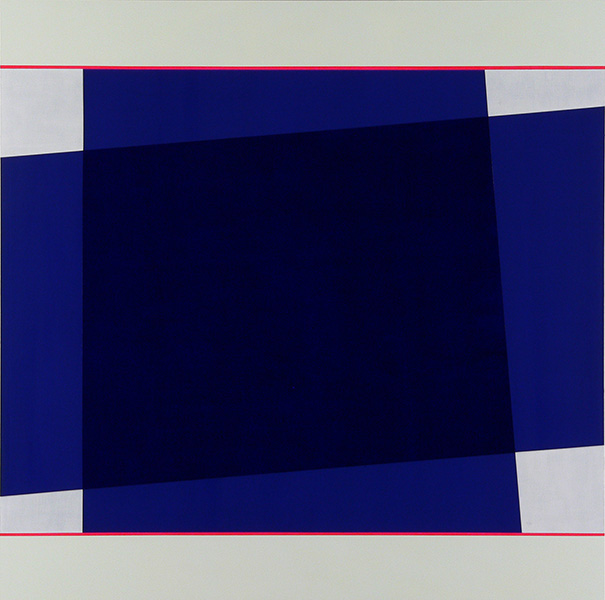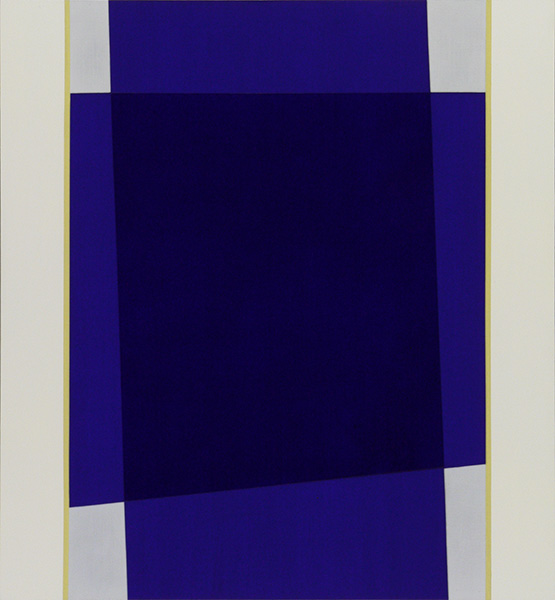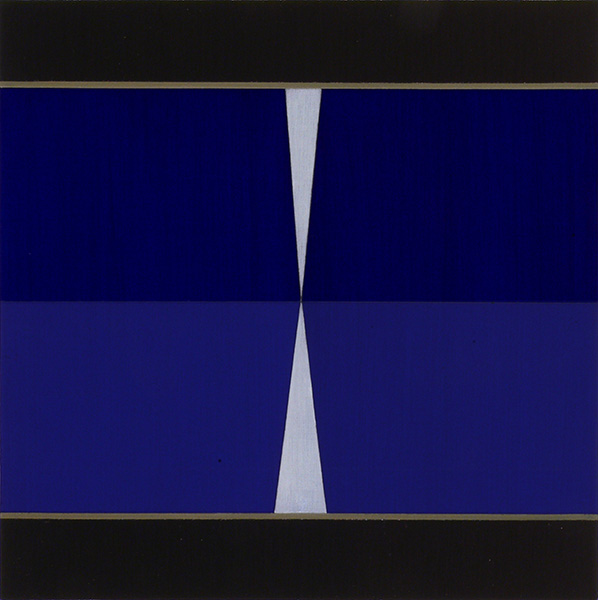
October 2, 2018
Don Voisine @ Gregory Lind
by David M. Roth
Don Voisine’s current cycle of paintings, Blues and the Abstract Truth, travels some familiar paths. They’re the same paths that have been trod by artists ranging from Piet Mondrian and Kasmir Malevich to Tony DeLap, Leo Valledor, Carmen Herrera and a host of others over the past century. From that fact, the question that invariably arises is: Can more be wrung from this brand of austere formalism than what we’ve already seen? I’ve raised this question before in relation to his Voisine’s work, and the answer is always an emphatic Yes. While the artist operates squarely within the nonobjective tradition and with the same variables he’s used in the past — flat surfaces, hard edges and geometric shapes constructed from interleaved volumes of matte and gloss pigment — the effects he achieves always surprise. And why shouldn’t they? After all, just because there are only twelve tones in the Western musical scale doesn’t mean that there’s an upward limit to the number of melodies that can be written. So it is with Voisine and painting.
He is the only artist working in this realm whose work sets my internal gyroscope so completely askew. It happens through the meticulous, off-kilter placement of standard and irregular geometric forms within a single plane, bounded (mostly) by white or by subdued shades of other colors. Working in concert, these features make his paintings behave a bit like Op Art in that they exert a magnetic pull that directs attention outward — to notches at the perimeters, and to places beyond the panels themselves, allowing the paintings to command more space than their modest sizes would otherwise warrant. The overall effect is one of subtle and sometimes extreme cantilevering and contortion. Invariably, there are times when viewing a Voisine exhibition when I think I’m inhabiting Floor 7 ½, the claustrophobic fantasy setting for Being John Malkovich, a 1999 film in which characters were sucked through a portal into the actor’s mind and then ejected onto the New Jersey Turnpike. (Nothing quite so dramatic happens in Blues and the Abstract Truth, but the compression of space is definitely real and certainly analogous to what’s seen in the movie when Malkovich and crew walk around hunched over, squeezed by the vise of a too-low ceiling.)
What differentiates this exhibition is color. Up until now black dominated the artist’s palette. Here, Voisine introduces deep, strong blues that push his oeuvre into a decidedly different realm, a spiritual realm. There’s an almost preternatural luminosity emanating from these works, a function of light and layering, matte against gloss, the effects of which are amplified by the torqued manner in which these expanses of color are presented. (For the record: other colors do appear in the show, but it’s the blues that dominate, serving as a kind of chromatic mascot.) All of which got me thinking about blue and why it elicits such reflexive joy and admiration.
Surveys over the centuries have shown blue to be humankind’s favorite color. This wasn’t always the case. Prior to the Middle Ages blue was notably absent from civilization, leading researchers to theorize (wrongly) that ancients may have lacked the neurological equipment to perceive it. Michel Pastoureau, author of Blue: the History of a Color, debunks that notion, citing many factors, the most significant being the church, which up until the 1300s, when the Virgin Mary began to appear swathed in blue, prohibited or severely restricted the color’s use in almost every activity under its domain. The absence of suitable and/or durable dyes along with technological, geographic and economic factors also played a role, but mainly it was the shifting ideology behind official taste that dictated the degree to which blue was in or out of favor. During and after Renaissance, blue’s popularity surged and it hasn’t stopped. Levi Strauss’s namesake product, Levis, was one potent weapon in the color’s ongoing charm offensive. So were the blues, a subject to which the author devotes exactly one sentence. “The music of this name is often sweet, pleasant, liquid; its semantic field evokes the sky, the sea, repose, love, travel, vacations, the infinite.” A greater mischaracterization (never mind a complete gloss-over of the music’s influence on 20th century popular culture) would be difficult to imagine. Yes, there are Love Boat-style “blues cruises” on which you can listen to music, but no one thinks of sea and sky when they listen to, say, B.B. King or Muddy Waters or Robert Johnson. Love, yes, but only the lost or gone-bad sort.
Which brings us to Voisine and the recording for which this exhibition is named, Oliver Nelson’s legendary 1961 release, Blues and the Abstract Truth. Nelson’s effort doesn’t carry the stature of Miles Davis’ Kind of Blue (1959), but it still ranks high amongst the cognoscenti, a group to which Voisine, a former drummer, clearly belongs. (See his interview in the Brooklyn Rail.) Nevertheless, with the exception of Mondrian’s Broadway Boogie Woogie (1942-43), which really does embody the fractured, syncopated characteristics of stride piano, I’ve always found links between jazz and abstract art to be strained, based more on fandom than any affinities that have been claimed to exist between jazz and Abstract Expressionism. Then, there’s the title, Blues and the Abstract Truth. It’s lovely and provocative. But seriously, when have you ever heard the blues sung abstractly? Yes, the blues are larded with rich metaphors (e.g. “there’s another mule kickin’ in your stall”), but they’re exactly that, metaphors, not abstractions. So where does that leave us in relation to Don Voisine?
For answers I turned to another book, On Being Blue: a Philosophical Inquiry by the late novelist William Gass (1924-2017). In it, Gass turns over a lot of rocks. The strongest argument he makes for blue’s seemingly inexplicable appeal is this: “Among the ancient elements, blue turns up everywhere: in ice and water, in the flame as purely as in the flower, overhead and inside caves, covering fruit and oozing out of clay. Blue is therefore most suitable as the color of interior life. Whether slick sharp high bright thin quick sour new and cool or low deep sweet thick dark soft slow smooth heavy old and warm: blue moves easily among them all, and all profoundly qualify our states of feeling.”
Voisine’s paintings qualify many such states.




